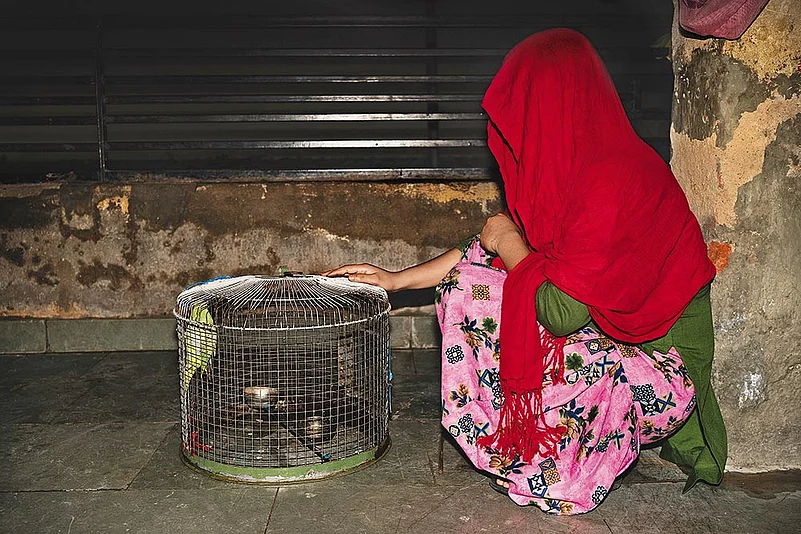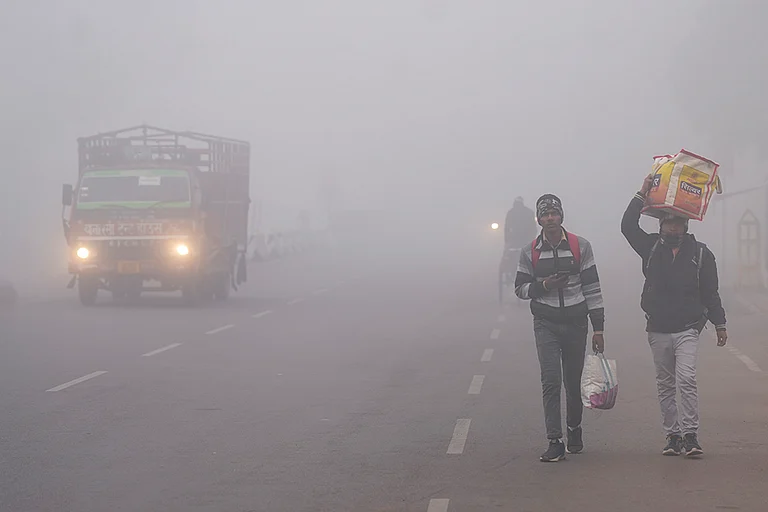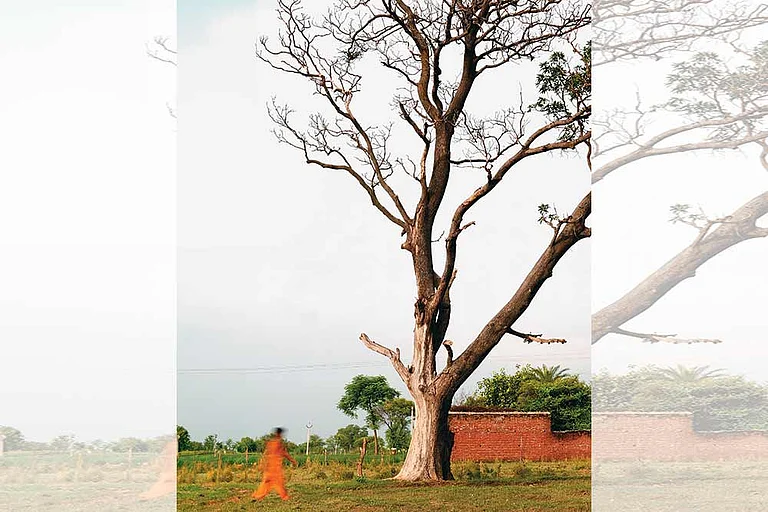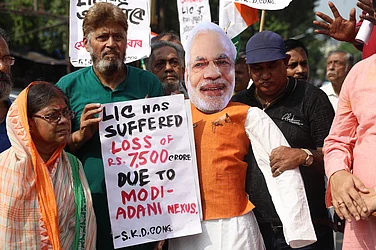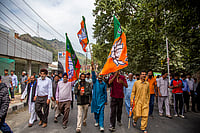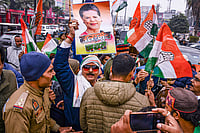This is the cover story for Outlook's 11 September 2024 magazine issue 'Lest We Forget'. To read more stories from the issue, click here
Twelve years after she survived a brutal gang rape, Shabnam (name changed), now 24, wonders whether dying on that horrible night would have been any worse. It would have spared her at least the battering of her soul that followed, even from those she had hoped to lean on. “I’ve been left to die a little every day,” she says. Her pleas for rehabilitation with dignity ignored by the authorities, Shabnam and her mother are currently lodged in a night shelter in Sikar, Rajasthan, where she endures “an unspeakable emotional torment”, she says, without opportunities for a steady livelihood or education. “Everyone keeps me at a distance. My brother doesn’t even talk to my mother because she lives with me. He believes my suffering has brought shame upon him. What was my fault?” she asks.
Justice had been served, it was said, when two of the accused were sentenced to life imprisonment on July 26, 2016 by the Sikar District and Sessions court, which also acquitted four giving them the benefit of doubt. The charges were under the Indian Penal Code sections of 363 (kidnapping), 366 (abduction of a woman with intention to compel her for forced marriage), 366(a) (inducing a minor girl with the intention of forced seduction and intercourse), 376(2)(f) and (g) (rape of a minor girl), 325 (voluntarily causes grievous hurt), 34 (common intention), among others.
Justice, however, hasn’t quite alleviated the survivor’s suffering or ensured her protection. Inside the cramped shelter, the air is thick with the stench of neglect—and of despair, deepened by the dark and filthy washroom on the ground floor that allows little privacy. The first floor, where mother and daughter stay, is easy to access—also for intruders. The struggle for basic privacy and security is a daily ordeal and reminder of the vulnerability that has been a constant companion since that night in 2012.

“I want to study to become self-sufficient, but I lack money and opportunities,” she says. “The government promised us a home and employment back then, when I was a child. Now that I’m an adult, if they do what they promised, it could transform my life.” She had started going to the local anganwadi, but was told to seek admission elsewhere. “They warned that if I didn’t stop coming, they wouldn’t let my younger siblings study there,” she adds.
Shabnam’s family had moved from a village in Bihar’s Darbhanga district to Rajasthan after her father’s death in 2012—a few months before the gang rape. Her brother-in-law, who was working in Sikar, invited them, suggesting her mother, too, could find work there. They rented a room in Sikar Industrial Area and her mother began working. On the night of August 20, Shabnam was returning home after watching a movie with her sisters and neighbours when two men—Suresh Kumar (25) and Naresh Kumar (26), who would be convicted in 2016—pulled her into a jeep and sped away. “As they grabbed me and ramped up the jeep’s speed, I was dragged along the road for a bit before I was pulled in, screaming,” she says. There were eyewitnesses who reported the jeep’s number to the police and provided descriptions of the two men.
“The government promised us a home and employment back then, when i was a child. Now that I’m an adult, if they keep their promise, it could transform my life.”
“While I begged them to let me go, they beat me mercilessly inside the jeep and threatened to kill me. I fell silent after a while. After driving for over an hour, they stopped briefly at an isolated place, where a young man handed them a packet of food and water bottles,” she recalls. For three hours or so, they drove deeper into the jungle, where she was beaten up again and gang-raped. “They tried to force me to drink. I was so badly injured that I eventually lost consciousness. I came around at 3 or 4 am when they sprinkled water on my face. I begged them again to let me go, but they said they would kill me to avoid identification and arrest,” Shabnam says.
The men took her to a house where she overheard a woman, perhaps their relative, advising them to abandon her somewhere remote. “Then they took me to a hill and left me there, in a semi-conscious state, unable to call for help,” she says. A passerby on a morning walk saw her and called the police, who took her to a hospital. “I don’t remember what happened next,” she says, tears in her eyes.
The two men in the jeep had no chance of evading the law due to the strong evidence against them, but K K Saini, public prosecutor, District and Sessions court, Sikar, claims the others, who had abetted the crime, would not have got the benefit of the police’s half-hearted efforts had they carried out the investigation with seriousness and sensitivity. “The Test Identification Parade of the accused, a crucial step, was conducted two years after the incident,” he says.
Four years of treatment and more than 20 surgeries—mostly reconstructive, including a rectal surgery—later, she says she still has mobility problems. “It was 12 years ago, but I still shudder at the memory, her condition was so painful,” says Dr L D Agarwal, who treated her. “The injuries were worse than they were in the 2012 Nirbhaya case.” For long periods her kin couldn’t visit her due to infection risks. While the case was under the media glare, with the government drawing much flak, she received treatment at various hospitals, including J K Lon and Sawai Man Singh Hospital in Jaipur and All India Institute of Medical Sciences (AIIMS) in Delhi, from where she returned to Rajasthan in 2016. The police left her first at her sister and brother-in-law’s home, but, when the media and rights activists pointed out that the arrangement offered little privacy or security, she was moved to a contested plot of land. This was also unsafe due to the frequent disputes. Media pressure made the police take her to the night shelter where she now lives—as a temporary arrangement. A large portion of the shelter had been demolished by the authorities years ago.
“It is crucial to allocate as much attention and resources to the rehabilitation and support of victims as we give to prosecuting their cases,” says Abhayanand, former DGP of Bihar. “The Department of Women and Child Development and other concerned agencies apparently fail to focus on mobilising resources for rehabilitation efforts to ensure victims get the support and assistance they need. It affects healing and recovery.” The chairperson of the Rajasthan Women and Child Welfare Committee could not be reached for comment.
The district administration claims Shabnam was given a compensation of Rs 5 lakh—the amount provided to rape survivors under the Rajasthan Victim Compensation Scheme, which falls short of addressing her ongoing needs. “We will review the complete file and ascertain the details. We will ensure she is admitted to school and any necessary support is provided,” says a senior official. Sikar Collector Qamarul Zaman Chaudhary could not be reached for comment.
In 2022, Rajasthan reported the highest number of rape cases in the country for the fourth year in a row, according to NCRB DATA.
If the victim belongs to a Scheduled Caste or Scheduled Tribe, Section 12(4) of the SC & ST (Prevention of Atrocities) Act mandates compensation of Rs 5 lakh for rape cases and Rs 8.5 lakh for gang rape cases. Half of the amount must be provided once the case is registered and medical examinations are conducted. The Rajasthan law also includes provisions for comprehensive rehabilitation encompassing health care, education, and even housing and government employment if necessary. Due to negligence, however, survivors in Rajasthan are receiving neither timely compensation nor complete rehabilitation.
Shabnam’s case is not the only example of inadequate rehabilitation of rape survivors in Rajasthan. On March 9, 2019, a six-year-old girl from the Tijara tehsil in Alwar district was raped. Her condition was so critical, she had to undergo two major surgeries and was unable to speak or walk properly for a long time. “We needed money for her treatment, but received no compensation even after months,” says a family member. “The authorities kept saying the funds would be available in a day or two. We had started sending the girl to school that year, but everything was ruined.”
In 2022, Rajasthan reported the highest number of rape cases in the country for the fourth year in a row, according to the National Crime Records Bureau (NCRB) data released shortly after an election that highlighted crimes against women as a key issue against the outgoing Ashok Gehlot-led Congress government. Rajasthan led with 5,399 rape cases, followed by Uttar Pradesh with 3,690, Madhya Pradesh with 3,029 and Maharashtra with 2,904. This rise is partly attributed to mandatory FIR registrations, which require police to lodge cases or face disciplinary action. The NCRB report notes a distinction between a genuine rise in crimes and an increase in crime registration due to police initiatives like e-FIRs or women help desks.
In a ruling last October, the Supreme Court addressed a plea from the Rajasthan government challenging a High Court decision that reduced a convict’s sentence for raping a child from life imprisonment to 12 years. Noting that monetary compensation alone is insufficient for rehabilitation, the apex court also pointed out that the social environment of the survivor may not always be supportive of her rehabilitation. Justices Pankaj Mithal and Abhay S. Oka also asserted that the State should ensure these children continue their education. “Whenever a child is subjected to sexual assault, the State, or Legal Services Authorities, should guarantee that the child receives counselling from a trained child counsellor or psychologist. This support will help the victim overcome trauma and lead a better life,” the judges ruled.
“In Rajasthan,” says rights activist Kavita Srivastava, a member of the People’s Union for Civil Liberties (PUCL), “there are several cases where victims receive no rehabilitation. While media coverage might prompt some investigation, there is no follow-up once the initial attention fades.” Pointing out that justice does not mean only sentencing and rehabilitation does not mean monetary compensation alone, she adds, “Rehabilitation means the survivor goes back to her normal life, is loved and accepted, and is not taunted. The State must take all steps like to ensure her safety, security and mental and physical well-being. Many women die due to the lack of financial support and care after their assault. Regardless of who is in power, the administration offers no real assistance for the rehabilitation of women who have suffered violence.”
When asked about Shabnam’s rehabilitation, public prosecutor Saini says she was awarded a compensation of Rs 5 lakh and the state bore her medical expenses. Asked why she has been kept in an unsafe night shelter, he said it’s the responsibility of the district administration. “There is no court order in this regard,” he says. Former Bihar DGP Abhayanand, however, points out that the prosecutor could have “prayed in court for a direction to the administration for proper rehabilitation of the survivor besides monetary help”. Abhayanand stresses on sensitisation of lower-rung police officials who investigate such cases with a “preconceived notion”. “It’s high time efforts were made to investigate any case with an open mind,” he adds.
MORE FROM THIS ISSUE
Indore-based psychiatrist Dr Manish Jain says survivors suffer from post-traumatic stress disorder (PTSD), which needs to be addressed with utter seriousness. “Our system does not take care of the deep psychological impact of such horrific incidents. The survivor in this case must be given education, a job, and a safe and healthy accommodation to overcome the physical, mental and behavioural trauma,” he says, adding the administration does none of this, especially when the victim is poor. The psychological disorder is not even covered under the medi-claim insurance companies offer. “Ensuring the survivor is accepted in every walk of life is the responsibility of a civilised society,” he says. “Only then does it have a moral right to raise its voice against such heinous crimes.” And until then Shabnam’s story would reflect the harsh reality of many survivors whose trauma from the assault is compounded by the indifference of the system and the society towards their well-being.
(This appeared in the print as 'Don’t You Remember My Story?')






